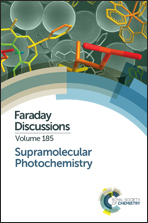An electrochemiluminescence-supramolecular approach to sarcosine detection for early diagnosis of prostate cancer†
Abstract
Monitoring Prostate Cancer (PCa) biomarkers is an efficient way to diagnosis this disease early, since it improves the therapeutic success rate and suppresses PCa patient mortality: for this reason a powerful analytical technique such as electrochemiluminescence (ECL) is already used for this application, but its widespread usability is still hampered by the high cost of commercial ECL equipment. We describe an innovative approach for the selective and sensitive detection of the PCa biomarker sarcosine, obtained by a synergistic ECL-supramolecular approach, in which the free base form of sarcosine acts as co-reagent in a Ru(bpy)32+-ECL process. We used magnetic micro-beads decorated with a supramolecular tetraphosphonate cavitand (Tiiii) for the selective capture of sarcosine hydrochloride in a complex matrix like urine. Sarcosine determination was then obtained with ECL measurements thanks to the complexation properties of Tiiii, with a protocol involving simple pH changes – to drive the capture–release process of sarcosine from the receptor – and magnetic micro-bead technology. With this approach we were able to measure sarcosine in the μM to mM window, a concentration range that encompasses the diagnostic urinary value of sarcosine in healthy subjects and PCa patients, respectively. These results indicate how this ECL-supramolecular approach is extremely promising for the detection of sarcosine and for PCa diagnosis and monitoring, and for the development of portable and more affordable devices.
- This article is part of the themed collection: Supramolecular Photochemistry

 Please wait while we load your content...
Please wait while we load your content...